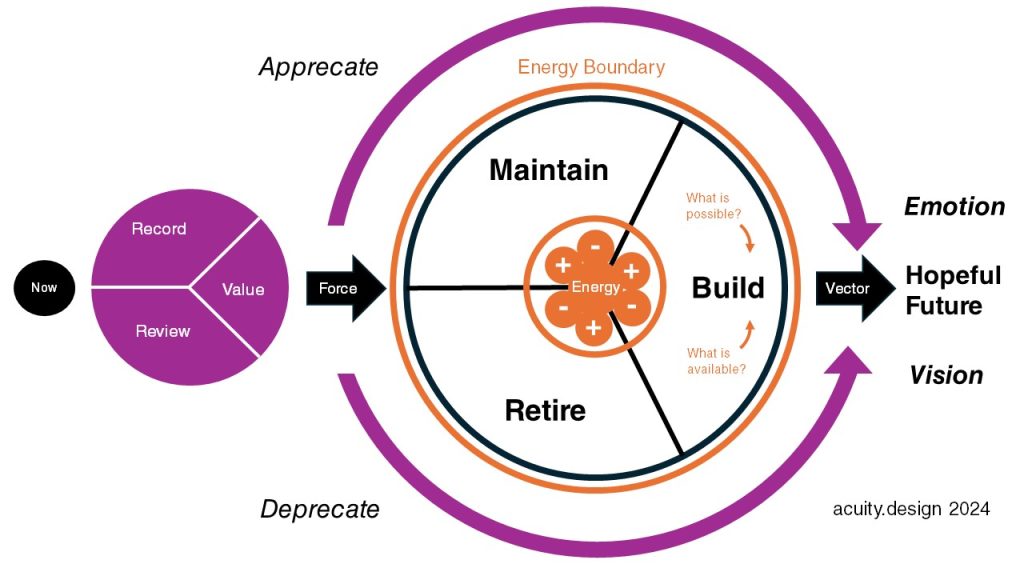
This is a short post about a model for talking about design in the climate crisis. The complete diagram is complicated so I will work thru the elements and build up the meanings I am trying to communicate.
Hope and Energy are critical themes. The underlying mechanism is Permaculture and having a sense of direction in using Force.
This model comes out of reviewing work I did for the Design Council on design thinking and the Climate Crisis. In particular, the rift between climate activists and professional designers in language and action planning methods. Tho they shared intents, they distrusted the way in which the others spoke or acted. This model is an attempt to use a slightly different framing to create a shareable human space for discussions and actions.
From Now…

Let us start with a bounded space. The boundary is Time. We start in the Now and move towards the Future. Really it is many different futures as choices and actions multiply but they all collapse into a single Future that we personally encounter and perceive. Be aware other people will perceive different versions. Listen to them and be open to what is felt.
Hoping for better

Hope is the way we gain some sense of agency from now to the future. A belief that we can move into a better place. This may seem a bit like religion and some ideas from Christian theology will appear later. Oddly because some software engineer decided to redefine a religious word.
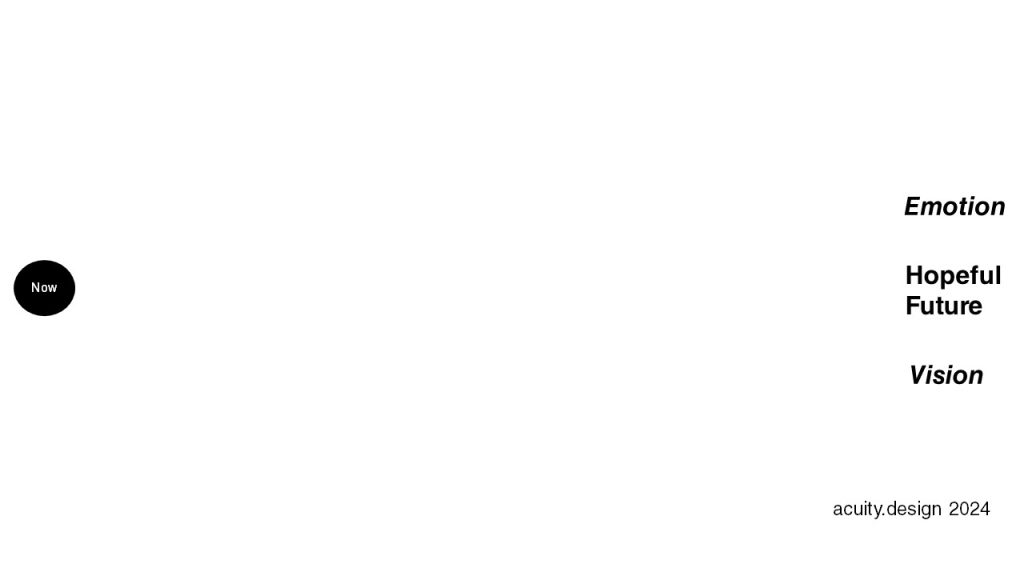
In the Design Council’s toolkit on design thinking and the Climate Crisis there is a tool, developed by Cassie Robinson (from an idea in Rob Hopkin’s book From what if to What is), for creating shared hope and visions of possible futures. I have used a few times and it is very good. The key to its ability is that it starts with asking about the emotional sense of a hopeful future. What does the future feel like? This is a powerful question and directly attaches people to their hope for a better future. This emotional string then runs thru the project from now, thru the actual action and hard work to that future. Once that emotional sense of the future is created, then visions (what it looks like, sounds like, etc.) can be added on. The emotion is the heart, the vision is the body. More than any other route mapping and envisioning tool I have used, this one enables a shared hope that is resilient to the fears and trepidations of both communities and organisations because it has an emotional heart.

These senses of the future, the emotion and the vision, create a vector for the project. They provide direction. Time is the boundary, hope is the direction.
How do we get to that future? We must use force and belief. These are the model’s heart.
Going somewhere needs force
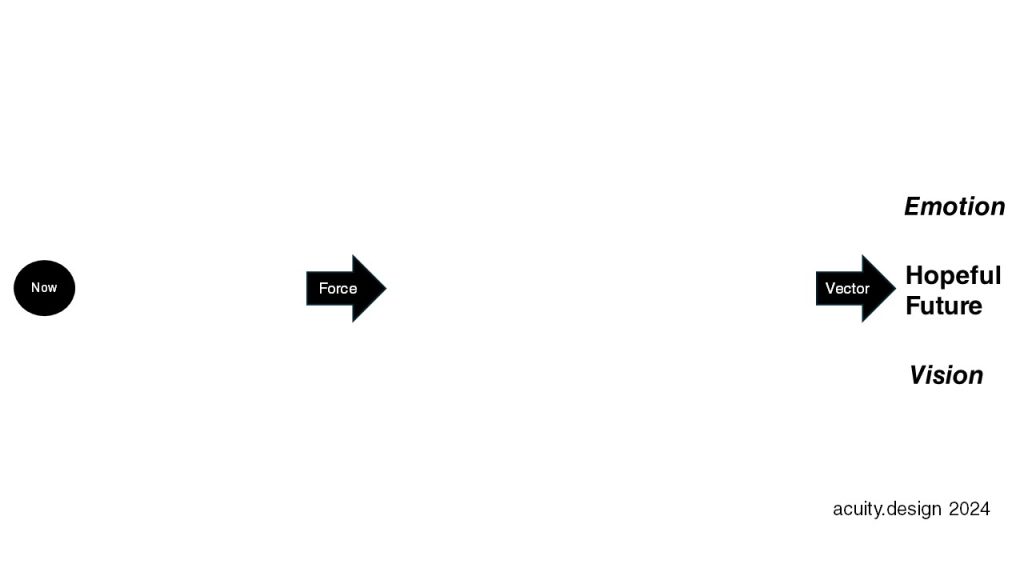
We are going to use force to get to the future. Action needs energy. The vector is directed force.
So what do we do? This is the Permaculture part: thinking about how to change from what we do now to what we want to do in the future. Planning actions but starting first with not ideation about innovation and change but looking around and valuing what works.
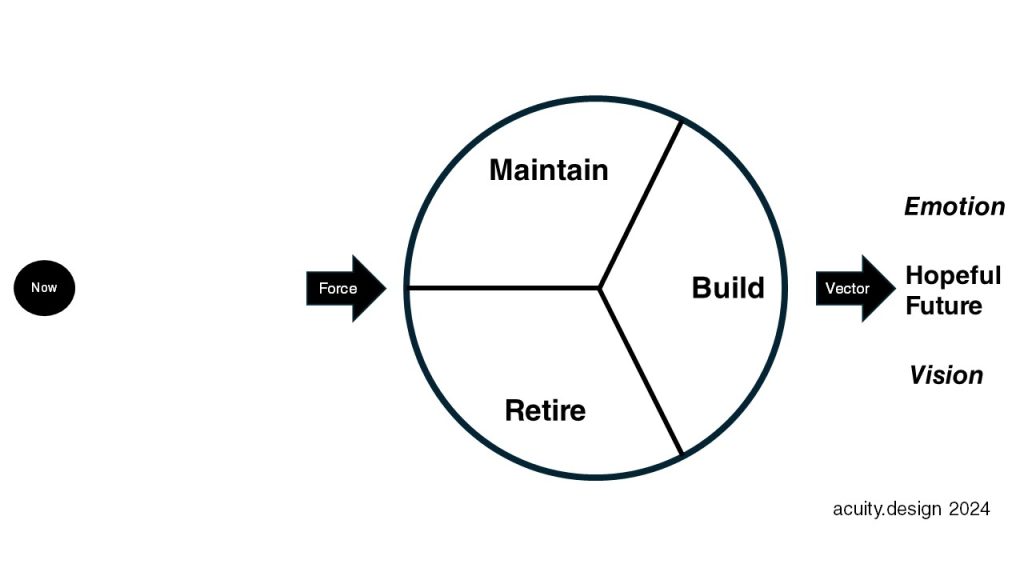
Three choices of actions to take. Primary action is Maintain. Value what works and already exists and keep it going. Infrastructure as the core to any future. Retire is next possibility. Consider what does not work well: is it actually toxic or just not efficient? Perhaps those parts should be removed? When is a good question and that will come out more when Energy is discussed. Finally Build. What needs to be designed and made that is new to this time and place. Innovation as the last action to take. This is, as with Retire, because Energy use is the key. Simply throwing away and building completely new artefacts is a consumer society idea. Permaculture moves us into a future where we change but not rapidly and not with sudden disjunctures of new products and services.
All because of Energy.
The Energy Boundary
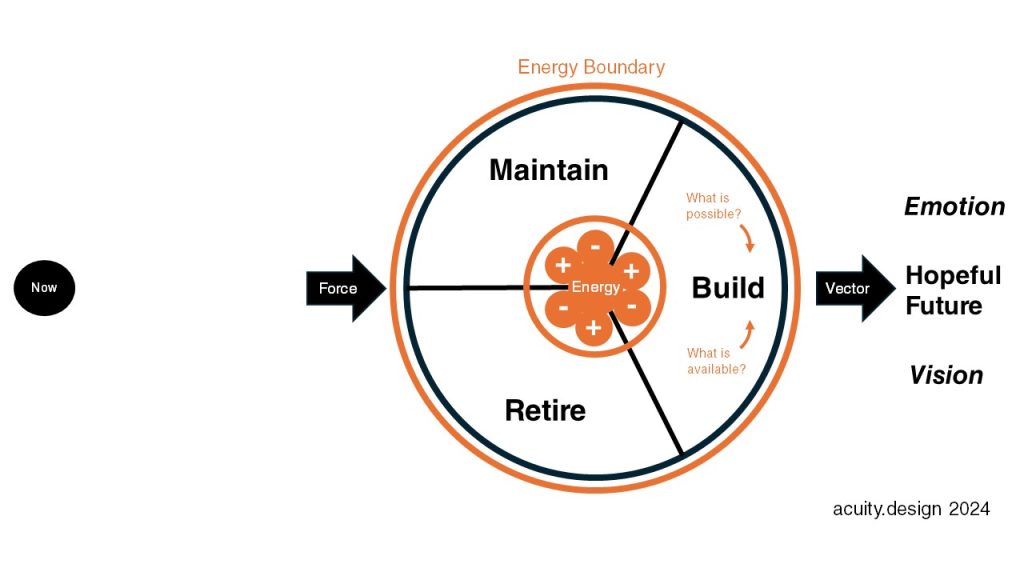
If the systemic change is about force and vectors then the heart of the mechanism of action is energy. How we make it, how we use it, how we use it more efficiently, how we stop using it and how we use it to make new things. Energy is the boundary for our actions. It is not limitless and its use can affect both our planet’s ecologies and climate. Again, we just cannot innovate our way to the future by stopping what we do without considering energy and building new things without costing materials and energy used.
Permaculture offers a way of thinking and judging what actions to take.
The best use of available energy is to keep doing the things you judge as valuable now and into the future. Value what works and maintain it.
Retire what is toxic or inefficient. This sounds simple but is not.
Binning and burying rubbish has energy costs too. Some processes are inefficient but the cost of retiring them may be very great. Again, the consumer society model ignores disposal costs (in symmetry with how it does not fully cost innovation and bulding new stuff). Understand the value of retirement and disposal, choose when to do it and how to do it over time.
Build new products and services but ask two questions. What is possible? What is available?
Within the energy boundary, we are using and maintaining what we value in the furure and we still using and carefully retiring what we do not value in that future. The space left for Build is pincered between Maintain and Retire. What is possible is constrained by what we can imagine and design using the ideas we share for the hopeful future. What is available is the constraint of energy and materials for innovating and making.
We cannot use more energy as the Earth has limited resources and the climate cannot bear more energy being released into the weather systems. The boundary forces choices about what works and does not work but also what the energy costs of doing good and bad are. Innovation may not be the best choice if energy is the measure. Retiring existing inefficient processes may not be the best choice if energy (made and used) is too great.
Let us pray

You need to have a belief system under your systems of action. As I mentioned earlier, there is a word that software engineers borrowed from religion.
It is deprecate. It is used when planning the retirement of products and services. They are deprecated: things stop working on certain old software platforms (as you are supposed to upgrade to the latest one), things stop working at all (as the company no longer wants to do that or most customers do not want it anymore).
There is another word which is the opposite. It is apprecate.
Both these words come from Christian theology and are part of discussions about prayer. Praying for what you want or want to happen (apprecate) and praying for what you want to avoid or do not want to happen (deprecate). All this is drawing from the Latin word precari for to pray.
This seems reasonable when the whole model is aiming toward hoped for futures. Prayer framing actions to lead us towards the shared, better futures we imagine emotionally and viscerally.
I am reminded of Solstice in December. In Stroud, there is a ritual spiral where people can walk into the circle holding an unlit candle and think about their last year. At the centre, they stand and light their candle from the single candle illumiating the space. As they walk out of the spiral, they can contemplate the new year and new possibilities.
It is a ritual of prayer and energy.
That all seems relevant to this model.
We need emotions for hope and we need belief for actions.
Prayer is a moment of consideration. A time to stop and reflect. Stopping matters in all human projects.
Valuing what we have and what we do
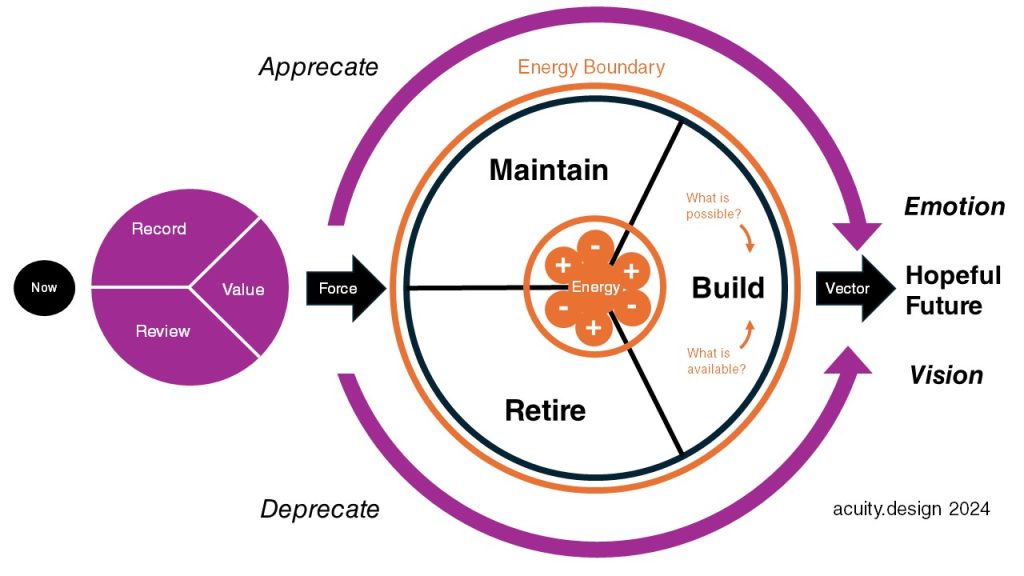
Permaculture asks you to stand still in the now and value what you do.
It is a moment of prayer. Value what you do well, be explicit about what you do that is not great and state what you hope to do in the future (more good, less bad generally) so you can get to that hoped for future.
This is project audit, alignment and planning. Record what you have done so you have some way of coherently reviewing it and judging the value of what you do and hope to do.
The model is a repeated cycle. Not one big action or giant leap to get from now to the hopeful future but many attempts thru time. We stay still and review where we are, we pray/we plan what to do next and when we are done then we stop and review where we are now. Many steps, many reviews, many prayers for many hopeful futures.
Looking at some parts again
Degrowth
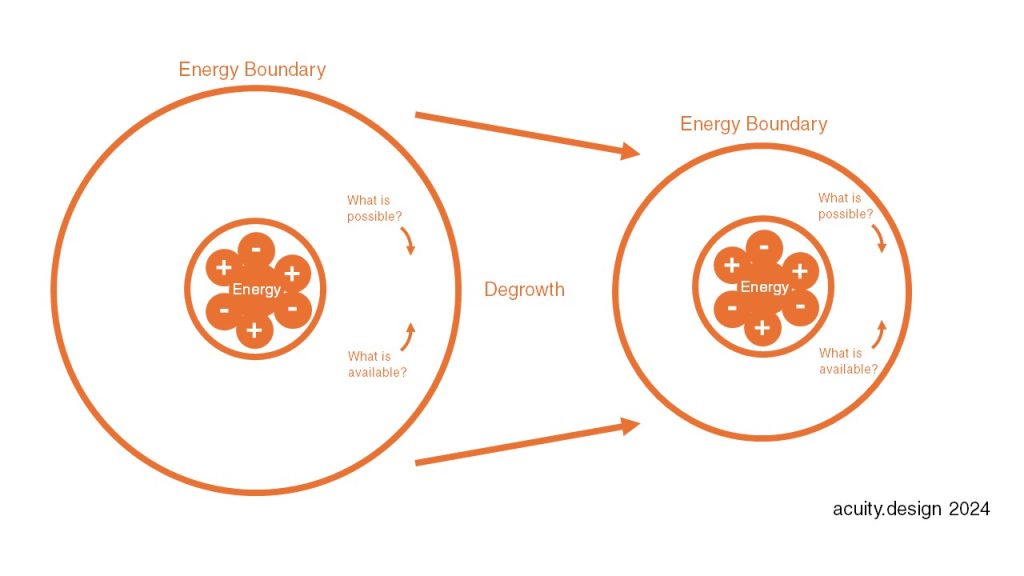
Just to look back at some elements and highlight some points. With the Energy Boundary part, it is useful to think about Degrowth. How we plan for futures where less energy is used in total. This shrinking of the boundary is a way to consider how Build may be further constrained in the future.
Belief structure not road map
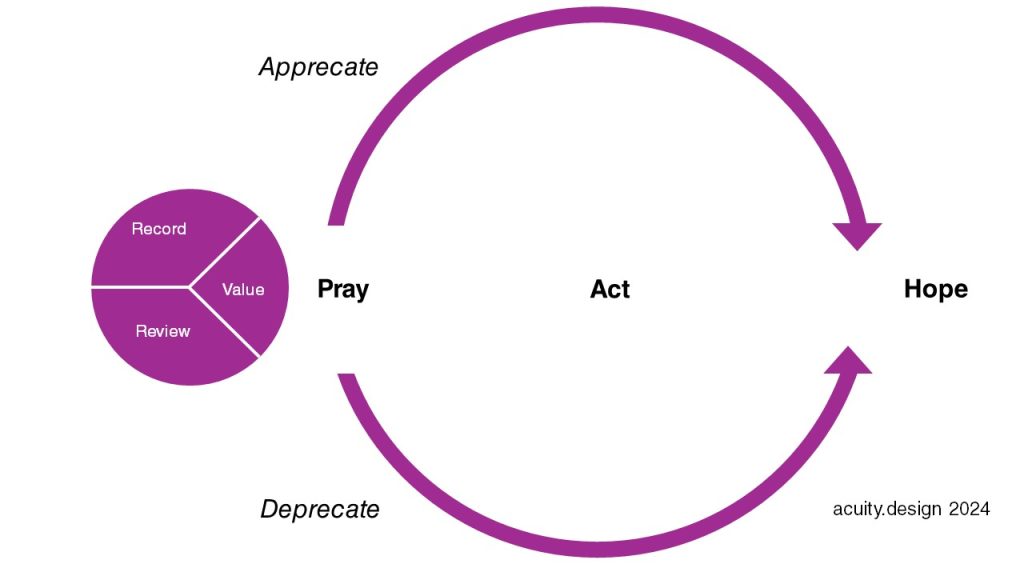
The emotional and spirtual elements of the model may unnerve people. Project planning prefers big blocky graphs of interdependent systems and actions (like Gantt Charts) or flowing maps of user journeys and road maps. Putting emotion, belief and prayer at the centre of a model is tricky.
Yet we need these parts of our shared humanity to get to the hopeful futures. Some of the issues of design in the climate crisis are vast (in physical and temporal terms) and it is thru the vastness of our spiritual beings that we can approach them.
We use our engineering, science and digital tools as actions for moving towards our hoped for futures but it is our humanity and spirituality that frames and directs those changes.